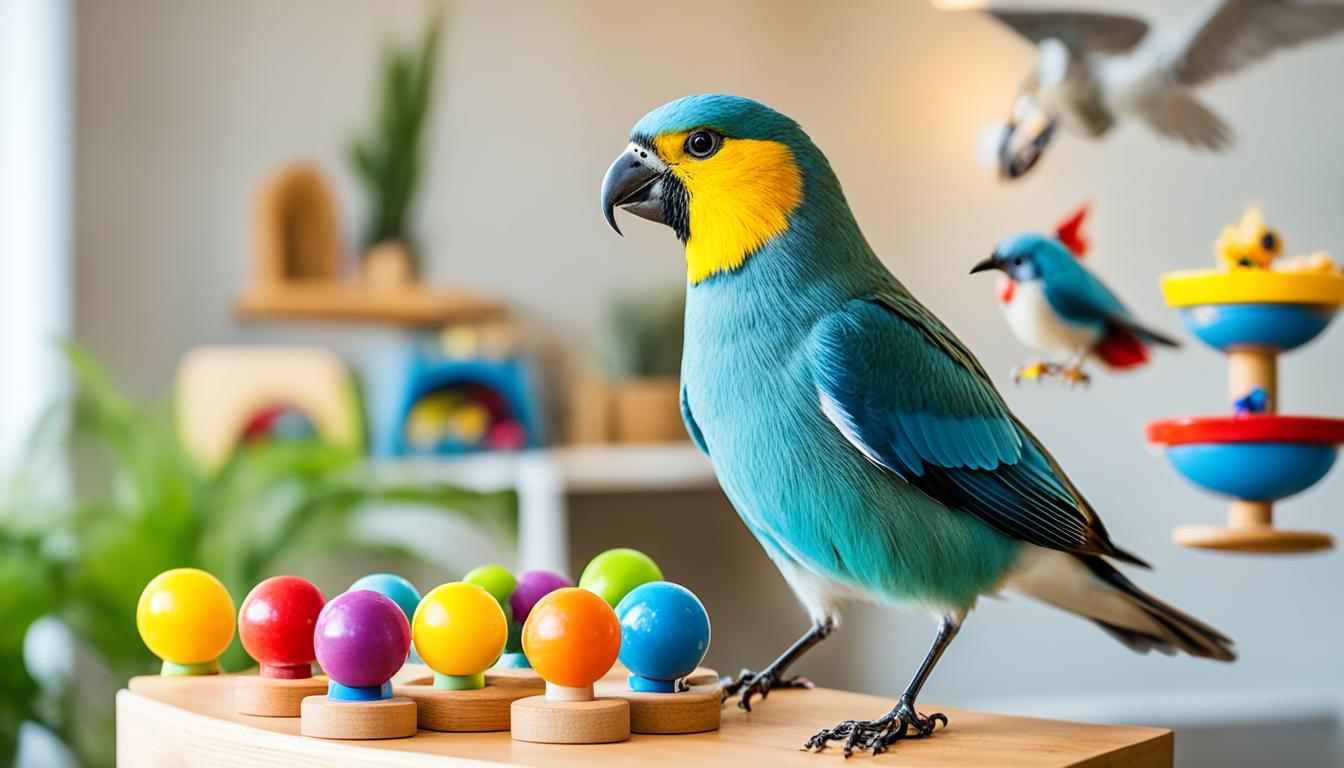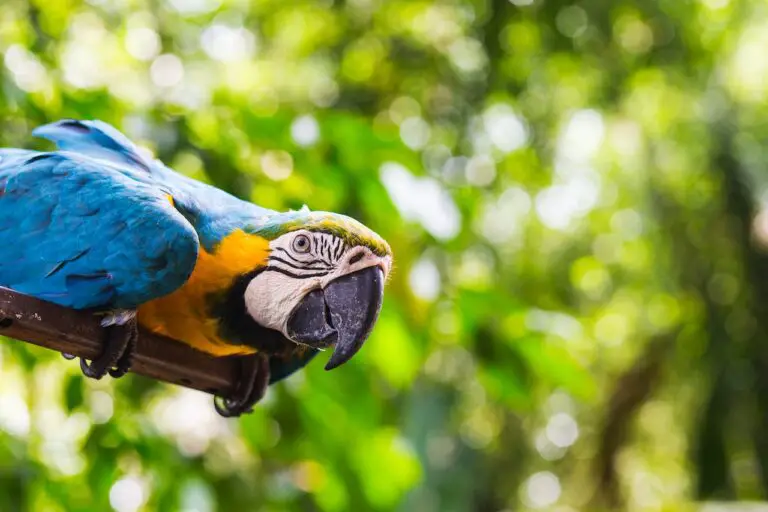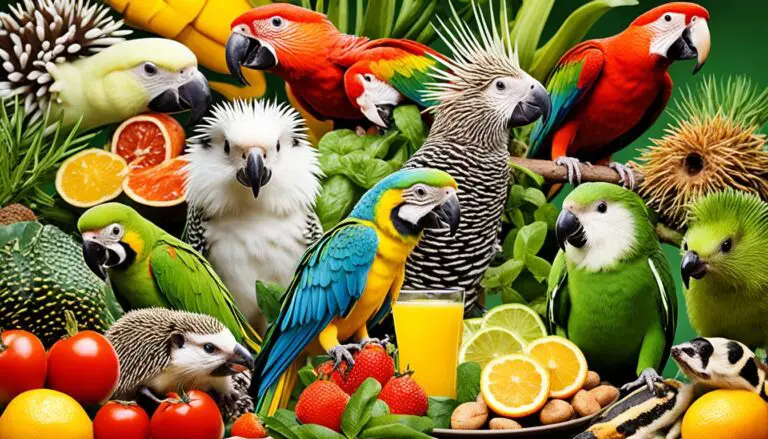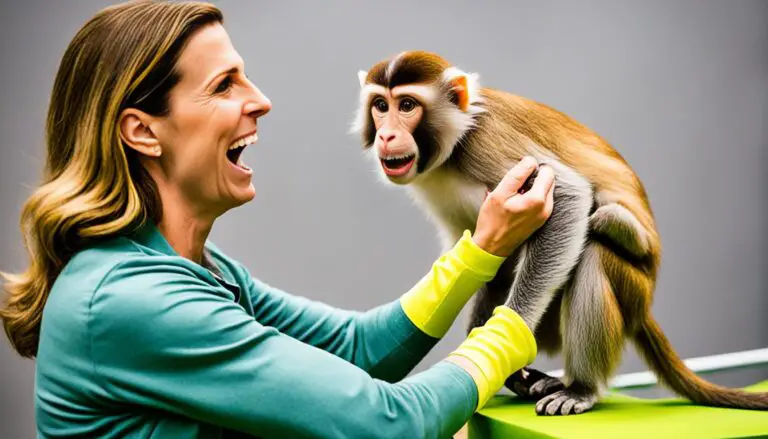Exotic Bird Training Tips for a Harmonious Home
Did you know well-trained birds are 70% less likely to have problems? By picking up and using some top-notch bird-training tips, you can make friends with your feathered pal. Your daily chats with the bird are key to how it behaves. Just like how meeting Person A or Person B affects our mood, showing love to your bird can totally change its attitude and how well it listens to you.
Key to teaching your parrot well are methods like clicker training and target training. These way cool tricks help you be steady in your teaching. Plus, if you dangle the right treat in front of your bird, it might just start acting the way you want, and stop doing stuff you hate. Mixing up rewards, steering clear when they act bad, and using tricks to lead good behavior all help in training your little flying buddy.
Key Takeaways
- Daily interactions with your bird significantly impact its behavior.
- Establishing bonds through positive interactions is essential.
- Clicker training and target training are fundamental methods.
- Using snacks wisely can make training super effective.
- Using rewards is key in getting your bird to behave nicely.
Understanding Your Exotic Bird’s Behavior
It all begins with knowing exotic birds deeply. You need to understand your bird’s special needs and how it interacts with others. This helps make your bird’s life better and happier.
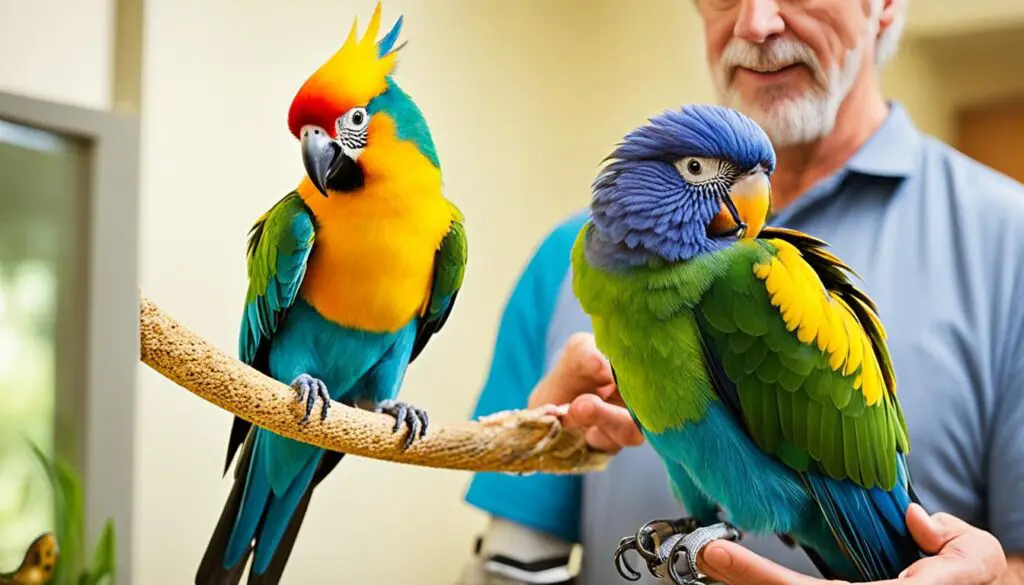
Species-Specific Needs
Exotic birds each have their own way of eating and living. It’s vital to feed them what they need to stay healthy. They should also see a vet regularly to stay well. Knowing this helps with training and taking care of your bird.
Social Interaction Requirements
Exotic birds love being around others. Good times with you can stop them from acting out. This is key for training your bird well. Make sure to spend quality time with your bird and teach it in a nice way.
Environmental Enrichment
Give your exotic bird a fun place to live. This means setting up games, different places to sit, and new toys for them. It keeps them active and happy. Such practices are vital in teaching birds and improving their behavior.
| Aspect | Importance | Examples |
|---|---|---|
| Species-Specific Needs | Essential for health and well-being | Tailored diet, regular vet check-ups |
| Social Interaction | Crucial for emotional health and behavior | Positive interaction, structured social time |
| Environmental Enrichment | Promotes mental and physical health | Foraging activities, varied perches, new toys |
Work on these key areas for better training and a strong bond with your bird. Using good training methods helps your bird behave and be happy.
Effective Bird Training Techniques
Learning how to train birds can make your bond stronger. You can use clicker training, positive rewards, and shaping behaviors. These methods help your bird learn good actions.
Clicker Training and Target Training
Clicker and target training are key for birds. Clicker training means using a sound to tell birds they did well. They earn rewards for doing the right thing. Target training adds using an object to guide the bird to a certain action.
Positive Reinforcement Methods
Positive reinforcement means rewarding good behavior. Treats, kind words, and play are some rewards. It’s important to be consistent with rewards. This makes learning fun and effective for exotic birds.
Shaping Behaviors
Shaping teaches birds complex actions step by step. It starts with something simple and adds more. This allows birds to learn skills slowly but surely. It can be a very rewarding way to teach your bird new things.
| Training Method | Description |
|---|---|
| Clicker Training | Uses a click sound to mark desired behavior followed by a reward |
| Target Training | Encourages bird to touch or follow an object to reinforce specific movements |
| Positive Reinforcement | Rewards healthy or desired behaviors with treats, praise, or play |
| Behavior Shaping | Breaks down complex behaviors into manageable steps, rewarding each phase |
Exotic Bird Training Tips
Training exotic birds is a fulfilling task. Recognizing their unique traits is key to success. Each bird has its own personality and likes. So, knowing this helps when teaching them tricks.
Start with basics like clicker training and target sticks. These tools help build a solid training foundation. This method mixes clicker training with positivity, aiding in effective learning.
The 60/40 rule advises spending 60% of training on known commands. The remaining 40% is for new bird training commands.
Choosing the right rewards is crucial in making a tailored training plan. Birds differ in what motivates them. Using their beloved treats wisely is key. Mixing up rewards can keep birds interested and ready to follow instructions.
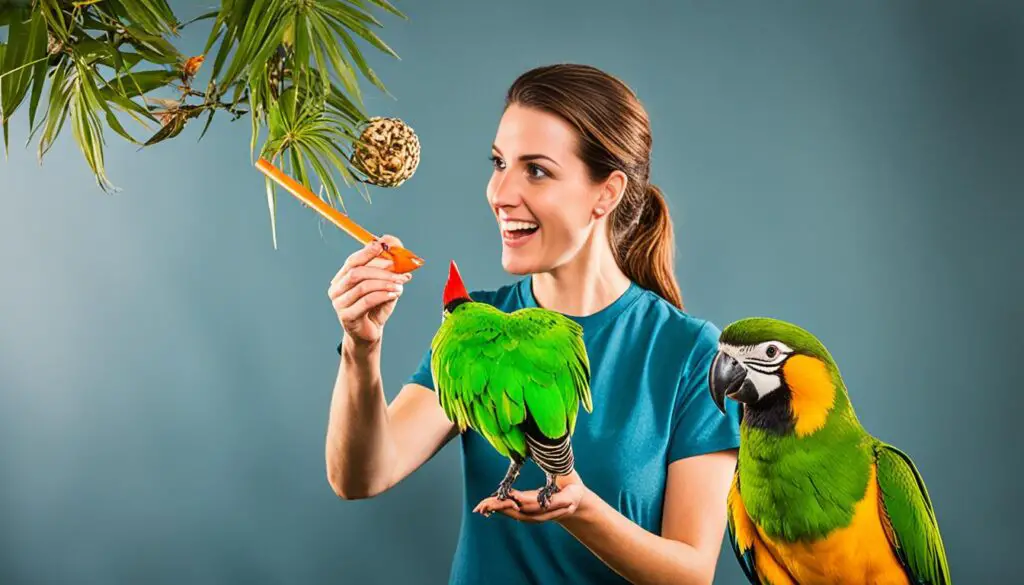
Consistency is crucial in training, but flexibility also matters. Some birds catch on fast, while others need more time. By using these strategies, you will find teaching exotic birds tricks for exotic birds a joyful experience. You’ll also have a well-trained, happy friend.
| Training Tool | Purpose | Benefit |
|---|---|---|
| Clicker | Marks desired behavior | Provides consistent feedback |
| Target Stick | Guides bird to a specific location | Helps with precise trick learning |
| Variable Rewards | Keeps birds motivated | Makes training sessions engaging |
| 60/40 Rule | Balances known and new commands | Ensures continuous learning |
Building a Bond with Your Exotic Bird
Creating a strong and trust-based relationship with your exotic bird is key. This makes training them easier and your home more peaceful. You can build this bond with training tools, using food to motivate them, handling them carefully, and introducing them to new places slowly.
Food Motivation Techniques
Using food to connect with your exotic bird works really well. Find their favorite treats to use during training and in everyday habits. Giving these rewards often not only helps in training but also makes your bond stronger. This makes the bird more eager to learn new things from you.
Handling and Socialization
Handling your exotic bird gently is vital for its happiness and trust. Be steady and kind when you touch and move them. It calms their fears and helps them get used to being around people. Also, it’s crucial to spend a lot of quality time with your bird to make them feel safe. This ensures they are friendly and calm around others.
Gradual Introduction to New Environments
Introducing new places to your exotic bird slowly helps lower their stress. Start by letting them get used to different parts of your home little by little. They’ll feel more confident and happy as they explore. This method also helps them get along better with you, forming a tight, cheerful bond.
FAQ
What are some basic exotic bird training tips?
How do I understand my exotic bird’s behavior better?
What is clicker training and how does it help in bird training?
How does positive reinforcement work in bird training?
What is the importance of shaping behaviors in training exotic birds?
How can I use food motivation effectively in bird training?
What are some tricks I can teach my exotic bird?
How can handling and socialization improve my bird’s behavior?
How do I safely introduce my exotic bird to new environments?
Why is environmental enrichment important for exotic birds?
What are the basics of bird obedience training?
How can I effectively use training tools for exotic birds?
What should I know about the 60/40 rule in bird training?
Source Links
- https://www.pandemoniumrainforestproject.org/blog-1/3dn07a1yhlhnnkue6h8pii8wvii2du
- https://birdtricksstore.com/blogs/birdtricks-blog/parrot-training
- https://www.animalcareunlimited.com/blog/exotic-pet-training-and-socialization-tips-for-building-a-strong-bond-with-your-bird-reptile-or-small-mammal/
Peter Stones is the founder of Exotic Pets Place, the leading online resource for exotic pet care information.
With over 10 years of hands-on exotic pet ownership experience, he is deeply passionate about sharing his expertise to help others properly care for their unusual pets.
When he's not writing extensively researched articles or connecting with fellow exotic pet enthusiasts worldwide, you can find Peter at home tending to his own beloved menagerie of exotic animals.

